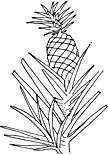View crop
View crop Data sheet EcoPortAnanas comosus
 |
|
| Notes |
|---|
| BRIEF DESCRIPTION A herb reaching 75-125 cm in height, with a short and thick stem, rosette leaves, and a terminal in florescence and fruit. The fruit is a multiple fruit formed by the almost complete fusion of 100-200 berry-like fruitlets. It may weigh between 0.5 and 2.5 kg. USES The fruit contain about 14% sugar, vitamins A, B, and C, and bromelin, it is eaten fresh or canned as dessert, cooked in dishes, and used for juice. Sugar-syrup is obtained from the mill juice. It is a good source of alcohol and citric acid. The leaves yield a strong, silky fiber. Mentioned as a useful agroforestry species. KILLING T Damaged or killed at 5°C for prologed time, 0°C for a short time. GROWING PERIOD Perennial, requireing 11-36 months to fruiting. The period from flowering to fruit ripening is 180-210 days, and the growth cycle is 330-365 days. Economical life usually 2-3 years, though the plant may continue to live and fruit for over 50 years. COMMON NAMES Pinapple, Ananas, Nenas, O abacaxi. FURTHER INF Scientific synonyms: A. sativus, Bromelia comosa. Pinapple originated in tropical America. The cultivation is largely limited to latitudes between 25°S and N, but it can be found to 33°S. In Kenya it is grown between 1400-1800 m in elevation, at lower altitudes the fruit is to sweet. In Hawaii it can be grown between sea level and 600 m, and in the Philippines between 500-800 m. Fruit tends to be smaller and less sweet at higher altitudes and most pinapple are grown near the sea in areas with a high atmospheric humidity often on hill slopes. It requires a high relative humidity. In subtropical regions it can only be grown in frost-free areas. The optimum yield is 60-80 t/ha for the first harvest, first ratoon crop yields approximately 10% less, the second ratoon crop 30% less. | Sources |
| SOURCES (A. comosus (L) Merr.) Sims D (pers. comm.) Roecklein J 1987 pp 232 [USE] Rice R 1990 pp 101-106 [KTMP, TEXT, DRA, PH] Landon J 1984 pp 280 285 [TEXT, DRA, DEP, PH, FER, SAL, TEMP] Maas E 1990 pp 281 Rhem S 1991 pp 186-190 [RAIN, TEMP, LIG, DRA, TEXT, PH] Doorenbos J 1979 pp 118 Samson J 1986 pp 191-215 [KTMP, TEMP, LIG, RAIN, SAL, PH] Eswaran H 1986 Kozlowski T 1977 pp 113 Williams C 1979 pp 38-49 [TEMP, RAIN, TEXT, PH, FER, DRA] Bartholomew D 1987 [RAIN, TEMP, LIG, DEP, DRA, PH, SAL, TEXT, FER] Hackett C 1982 pp 30 [FER, PHO, DEP, PH, TEXT, TEMP] Nair P 1980 pp 149-154 [RAIN, TEMP, TEXT, FER, DRA, USE] Duke J 1982 pp 14 Van Waveren E 1993 pp 31 Singh R 1969 pp 117-120 [FER, TEXT, DRA, LIG] Purseglove J 1972 pp 76-91 [KTMP, TEMP, RAIN, TEXT, DRA, PH, PHO, USE] Verheij E 1991 pp 66-71 [USE, TEMP, KTMP, LIG, PHO, DRA, RAIN, TEXT, FER, PH] |